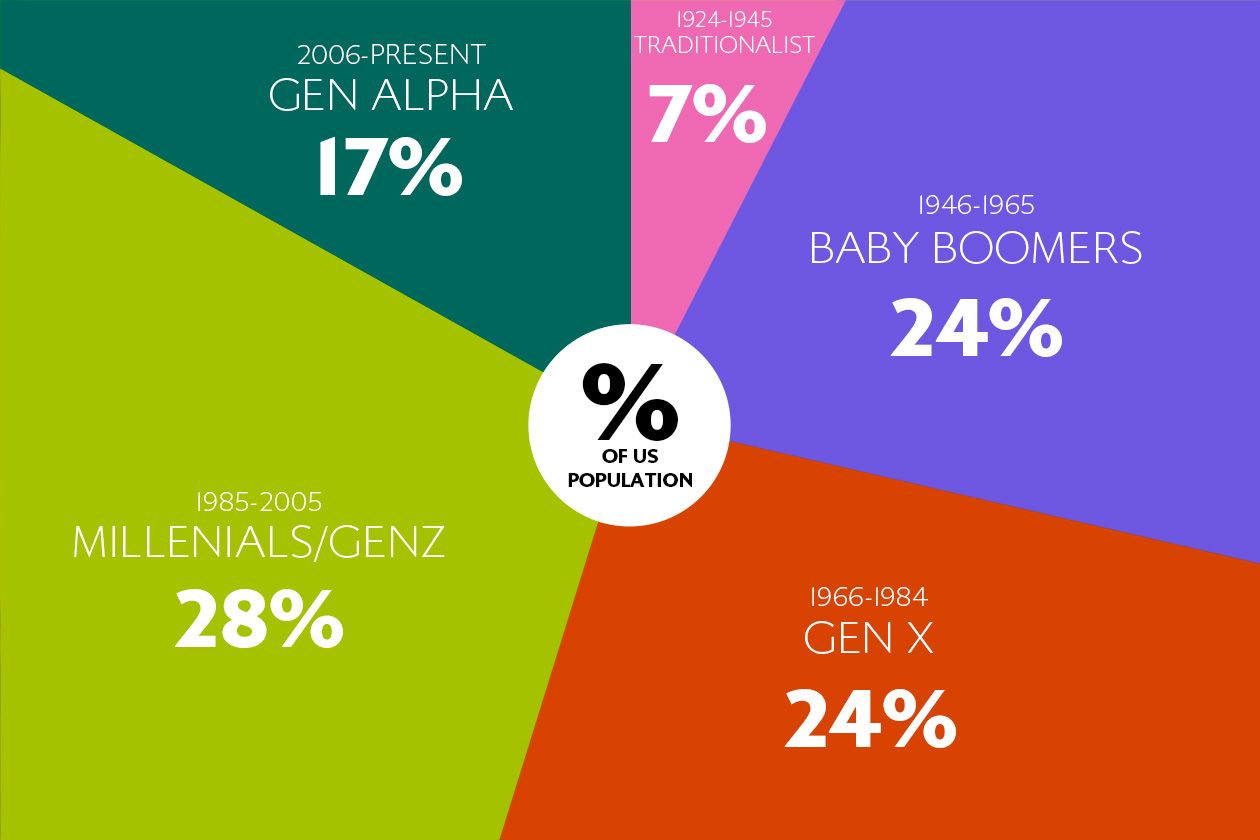Welcome back to part 2 of our recap of the November 2nd Flint & Steel speaking opportunity we hosted with speaker Kristin Scroggin on generational diversity within the workforce.
In part one we looked at the demographic breakdown of the different groups and what key characteristics defined each section.
Now, in part two we will look at how, as a manager or business owner, you can not only balance these wildly diverse types of personalities within your workforce, but also utilize the skills and talents each group brings to really maximize their potential.
The first thing we need to talk about when discussing unifying a generationally diverse team is conflict resolution.
When you have a group of individuals from the same generation, they are bound to have similar views on any number of issues including politics, family, religion, work ethic and work-life balance. Across generations there are very different views of each of these topics, and in some cases, how one generation views them may be in direct opposition to how another generation views them. These opposing views can result in clashes between individuals and groups, causing a ripple effect that can impact recruitment, training, retention, productivity, customer service, and ultimately workplace morale.
For example: communication styles.
As we discussed in our first blog in the series, Boomers are receptive to the idea of phone calls and in person meetings. To an Alpha Generation, neither option is a pleasant one. As a generation raised on technology, they prefer texts to quickly pass information back and forth. A Boomer could find themselves constantly frustrated by the fact that their Alpha teammate will send them ideas and messages via text. And the Alpha in turn may find reading long winded emails or listening to phone calls tedious and slow. While neither intends to irritate the other, the fact that both have such different preferences for communication is bound to lead to eventual conflict. A good manager and or business owner is one who understands these differences, is better prepared to address the individual employees’ needs and concerns and is better positioned to take advantage of strengths while reducing the impact of friction between different generations in the future.
During her talk with us at Flint & Steel, Kristin was emphatic when it came to dispelling the idea that any single group was better or worse than another. Rather, she wanted to remind us that as managers and business owners it’s up to us to lean into each group’s strengths and learn how to balance them all together into one cohesive and powerful team.
So how do you do that?
Here are three key conflict resolution takeaways Kristin shared with us during her talk that she said were quick, down and dirty ways to approach the generational demographic discussion.
1. You are not that special:
Kristin started out her talk by reminding the attendees that we are all products of our upbringing, and that how we were raised is directly influenced by how our parents were raised. While many of us were brought up with the idea that we are all unique and special in our own way (Mama was right, we are) that doesn’t mean there aren’t key characteristics that are similar within each generational group. While overall stereotyping isn’t encouraged (i.e., all Millennials are lazy, all Boomers are out of touch), it is a good idea for anyone in a management situation to be aware there are similarities between individuals within a generational grouping and that those similarities may affect the style you use when dealing with them both individually and in a group.
2. One size does not fit all:
With up to four different generations within any work environment, you are going to be facing four different working styles. Kristin was blunt in her assessment of the blanket style management that is often found in many current workplaces: failure. A one-size-fits-all approach to management is guaranteed to be a disaster. Generational issues include different approaches to problem solving and decision making, with some generations being fiercely independent (Gen X) and others requiring task lists and regular check-ins (Millennials). To point to any of these differences as weaknesses or strengths, you are automatically discounting and potentially alienating one of your four groups. Rather, look at these differences as work styles and manage accordingly. By playing up to their unique strengths and skills and not down their weaknesses, you’ll end up with a team that is cohesive and adaptable.
3. We’re more similar than we are different:
Rather than focusing on what sets each generational segment apart from the others, Kristin suggests that a good way to help bring such a diverse group together is to focus on how they are similar. Everyone, regardless of age, wants a job where they feel recognized, respected, and rewarded for the work they do. Another way to help bridge those gaps is by creating collaborative opportunities, where younger generations can learn from the older generations. Mentorship can provide valuable learning opportunities for up-and-coming employees while allowing those who have been around longer to feel heard and valued.
Part of being an effective manager or leader within your organization is knowing how to anticipate problems before they arise, and then knowing how to take action before the issue reaches a critical level. This is especially true when it comes to conflict arising from generational differences. Ignoring generational conflict simply sets up a situation that will continue to fester and may result in you losing valuable employees.
One way to make sure you are ensuring your team feels heard and seen is by applying the principles taught in the Anticipatory Organization Learning System. These principles encourage managers and leaders to be proactive in their thinking. By looking ahead to potential conflict before it arises, a good manager or leader can have a plan in place to help reduce friction. In addition, the principles encourage the fostering of collaboration between different groups within your organization to better help people discover common ground and build teamwork.
Try having each member of your team list their strengths, skills and valuable attributes they can share with the group. Odds are you’ll start to see some similar trends among the different groups. Do the same with the weaknesses they know they have. Comparing the lists of strengths and weaknesses against the different groups might provide some valuable feedback and show areas of overlap where one generation can step in to assist another generation (i.e. – technology for the younger generations is second nature whereas to older generations, it can be more of a struggle.)
When holding meetings, try to bring in individuals from all your generational demographics. Not only will you get a wide variety of viewpoints, but problem-solving skills from one generation may spark ideas in another generation and lead to collaborative solutions.

There are five generational demographics within the general population of the United States, with four (Boomers, Gen X, Millennials and Gen Alpha) making up the bulk of the current workforce.
Image courtesy of Kristin Scroggin.
Now that we’ve identified our different generational demographics and discussed how best to diffuse potential issues between the groups while also capitalizing on their strengths, how do you keep this team together for the long run?
Stay tuned for part three of our 3-part series where we will focus in on retention and values- and goal-related incentives.
For more incredible opportunities to hear valuable lectures and presentations like this one, check out our Flint & Steel series page for future dates and programming announcements as well as catch up on previous speakers you may have missed.





